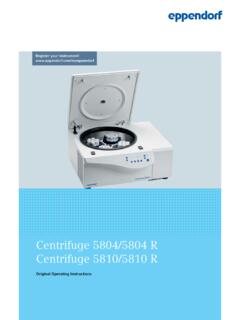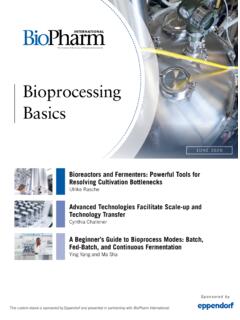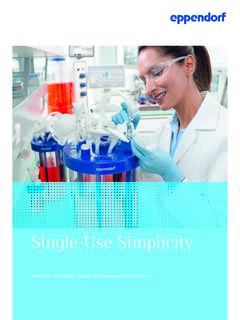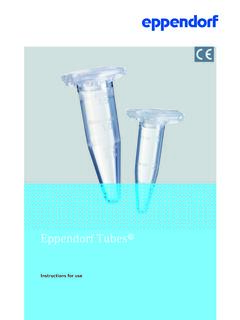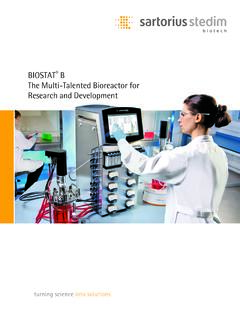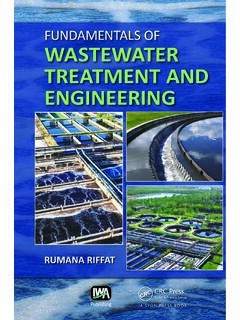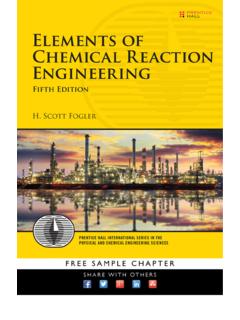Transcription of Cell Culture Scale-Up in Stirred-Tank Single-Use Bioreactors
1 Cell Culture Scale-Up in Stirred-Tank Single-Use BioreactorsBY MICHELET DORCEUSSPONSORED BY2 BioProcess International 16 (11 12 ) s i November December 2018 SponSoredBioprocess development usually is carried out in systems with small working volumes. This helps save time and resources because, at small scale, several experiments can be conducted in parallel. Costs for media are kept low, and relatively little laboratory space is required to operate small-scale Bioreactors . But over the course of development, biopharmaceutical companies need more material for characterization, trial runs, and finally for commercialization.
2 They transition to bench scale and then up to pilot or production scale with the intent to maintain constant yield and constant product characteristics. Often that brings some challenges. To deal with those, development groups must consider shear-stress levels, concentration gradients, and oxygen supply capabilities of production bioreactor systems during Scale-Up . One important factor is the Culture mixing time. As cultures increase in scale, developers want to ensure consistency in mixing because that can inf luence cells physiology. Therefore, both product quality and yield can be inf luenced by gradients in glucose concentration, oxygen, and pH.
3 As companies scale up to pilot/production bioreactor (s), they need to maintain Culture homogeneity to ensure an ideal growth environment at all scales. Key process engineering parameters related to Scale-Up include power input/volume ratio (P/V), impeller tip speed, constant mixing time, constant volumetric mass transfer, and constant oxygen transfer rate (OTR). The latter is an important factor for aerobic cultures. The volumetric mass transfer coefficient (kLa) describes the efficiency with which oxygen can be delivered to a bioreactor Culture for a given set of parameter conditions. For proper cell Culture Scale-Up , it is important to select equipment of different sizes with similar kLa capabilities so that small-scale success can be replicated at larger scales.
4 Mixing time is another important factor. As you scale up, you want to prevent concentration gradients and achieve homogeneity throughout each vessel. Cell Culture Scale-Up in Stirred-Tank Single-Use Bioreactors Michelet Dorceus Key process engineering PAR AMETERS related to Scale-Up include power/input volume ratio, impeller tip speed, constant mixing time, constant volumetric mass transfer, and constant oxygen transfer December 2018 16(11 12)si BioProcess International 3 SponSoredImpeller tip speed inf luences mixing time and oxygen transfer as well as how cells are kept in suspension. Usually tip speed (rather than agitation speed) is kept constant across scales.
5 The tip speed is equal to d N, with d being the impeller s outer diameter (m) and N being the agitation speed (rps). However, shear forces increase with increasing tip speed. Thus, it is important to find a suitable tip speed that allows sufficient mixing and oxygen transfer but does not cause too much shear stress to the cells. Keeping tip speed constant maintains a relatively constant shear force level, but it may reduce mixing-time performance in large-scale power input/volume ratio (P/V) can inf luence oxygen transfer and Culture mixing, as well. P/V can be converted from the impeller power number using the following equation: P/V = (Np p N d5)/Vwith Np being the impeller power number, p the density of water (1,000 kg/m ), N the agitation speed (rps), d the impeller outer diameter (m), and V the vessel s full working volume (m ).
6 In Scale-Up practices, power numbers are often determined without gassing. However, gassing greatly reduces impeller torque, thus having a significant impact on the apparent impeller power numbers as well as the results of aerobic processes. Maintaining constant P/V between vessels is one of the most common and prevalent strategies for Scale-Up strategies include the goal of keeping one or more parameters constant across scales. Which parameter is most important depends on the process. It is important to scale up your process using vessels with similar geometries and similar conditions ( , in terms of stirrer type, installation conditions, and process parameters such as filling rate, aeration rate, and type of gassing device and pressure).
7 Stirred-Tank BioreactorSThe Stirred-Tank bioreactor design is relatively easy to describe with classical engineering approaches (Figure 1). Parameters to describe this vessel geometry include impeller diameter, vessel diameter, liquid height, and ratios thereof. It is the bioreactor design for which most research on Figure 1: Stirred-Tank bioreactor designdDihVwmaxHiFigure 2: The BioBLU c Single-Use vessel portfolioBioBLU ModelWorking 1c 3c 10c 50c100 250 mL320 mL L L L18 L 40 L4 BioProcess International 16 (11 12 ) s i November December 2018 SponSoredscale-up phenomena has been conducted.
8 This knowledge has been transferred into Single-Use technology, as well. BioBLU Single-Use vessels have rigid walls to combine the best of both ( single - and multiuse) worlds. They have an industrial rigid-wall design for supporting Scale-Up within the BioBLU portfolio and beyond. They provide fast and efficient mixing with magnetically coupled overhead drives. And BioBLU Single-Use vessels are made of USP class VI certified material free of animal components. The BioBLU c Single-Use vessel portfolio offers the widest range of rigid-walled, Single-Use , Stirred-Tank Bioreactors available (Figure 2), with a working-volume range from 100 mL to 40 L.
9 Vessel geometry is similar across scales in terms of (among other things) the ratio of impeller diameter to vessel inner diameter and the ratio of maximum liquid height to vessel inner diameter. This facilitates use of BioBLU vessels at small scales during process development and then scale up processes to larger working volumes. Knowing the vessel characteristics and using the formula described above, we have calculated the tip speed at different agitation speeds for each BioBLU c Single-Use vessel. Thus, we have defined a scalable tip speed zone of m/s, which is reachable by all vessels. Case study #1A case study of monoclonal antibody (MAb) production using BioBLU Single-Use vessels was performed at our application laboratory in Enfield, CT, USA.
10 We investigated the capabilities of Eppendorf BioBLU Single-Use vessels for cell Culture Scale-Up from small to pilot scale. We took this process from a small-scale BioBLU (250 mL maximum working volume) and scaled it up 10-fold to the BioBLU 3c bench-scale bioreactor ( L maximum working volume) and then up to the pilot-scale BioBLU 50c (40 L maximum working volume). We used a DASbox Mini bioreactor system to control the BioBLU process; to control the BioBLU 3c and 50c processes, we used a BioFlo 320 bioprocess control station. We investigated the kLa capabilities of each vessel using the static gassing-out method.
